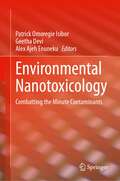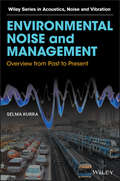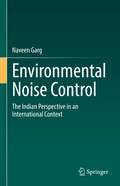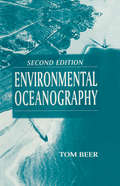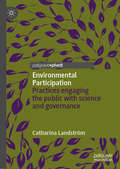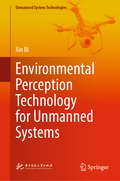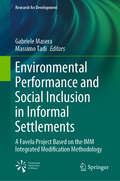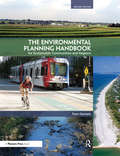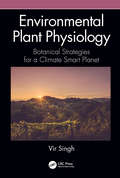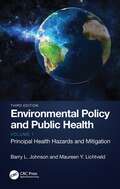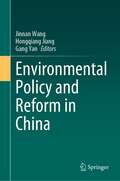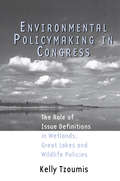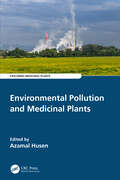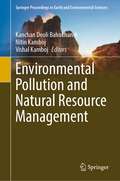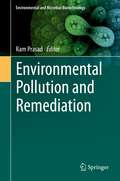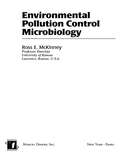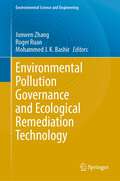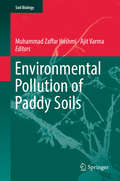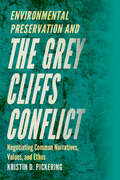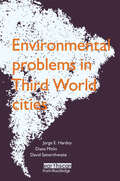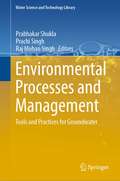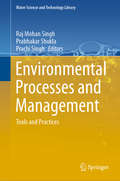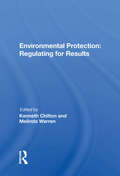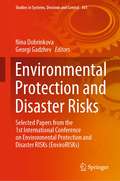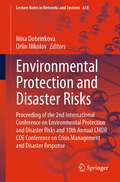- Table View
- List View
Environmental Nanotoxicology: Combatting the Minute Contaminants
by Patrick Omoregie Isibor Geetha Devi Alex Ajeh EnunekuEnvironmental Nanotoxicology: Combatting the Minute Contaminants is a comprehensive guide to the rapidly evolving field of nanotoxicology and its implications for environmental health and safety. This book results from the collaborative efforts of leading experts and researchers from diverse disciplines, aiming to thoroughly understand the interactions between nanomaterials and the environment and their potential impacts on the delicate balance of our ecosystems.Nanotechnology has witnessed remarkable innovations leading to the development of nanomaterials with novel properties and applications across various industries. Alongside these innovations, concerns have arisen about the potential risks that nanomaterials may pose to the environment and living organisms. This book addresses these concerns by comprehensively exploring the field's key concepts, principles, and methodologies. It includes case studies and offers insights into developing appropriate regulatoryframeworks and guidelines for the responsible use and disposal of nanomaterials. The book is a valuable resource for researchers and professionals working in nanotoxicology on the complex challenges posed by the intersection of nanomaterials and the environment. It is also an essential reference for students studying environmental science, toxicology, and nanotechnology.
Environmental Noise and Management: Overview from Past to Present (Wiley Series in Acoustics Noise and Vibration)
by Selma KurraEnvironmental Noise and Management Selma Kurra, Istanbul Technical University and dBKES Engineering Ltd, Turkey A comprehensive overview of environmental noise pollution from the standpoint of environmental impact and control Environmental noise is studied, regulated and monitored by many governments and institutions, as well as forming the basis for a number of different occupations due to the adverse effects of noise exposure. Environmental Noise and Management provides a comprehensive overview of environmental noise pollution. The book begins by covering the fundamentals of noise and acoustics, major noise sources and prediction and evaluation techniques. Developments in noise measuring techniques, and mapping and improvement of legislation to control noise pollution are then discussed, and international regulations are presented. Technological advances and recent developments regarding strategy and action plans are also covered in depth. Key features: Summarizes the relevant international standards covering noise pollution and environmental engineering practice. Presents technological advances and recent developments regarding strategy and action plans. Covers developments in noise measuring techniques, prediction models, mapping and improvement of legislation to control noise pollution. Environmental Noise and Management is a comprehensive resource for researchers and graduate students who are involved in noise pollution from the standpoint of environmental impact and control.
Environmental Noise Control: The Indian Perspective in an International Context
by Naveen GargThis book provides a concise and up-to-date overview of environmental noise control issues, utilizing specific case studies from India to help explore noise mapping and monitoring, impact analysis, and policy, among other relevant topics. The book provides an extensive review of recent studies, including references, and describes the latest noise monitoring structures. It also addresses heretofore under-emphasized topics, including but not limited to acoustic metrology, Multi Attribute Decision Making (MADM) techniques, and sound insulation utilizing passive control strategies.
Environmental Oceanography: An Introduction To The Behaviour Of Coastal Waters (CRC Marine Science #11)
by Tom BeerThe second edition of Environmental Oceanography is the first textbook to link the needs of the coastal oceanographer and the environmental practitioner. The ever-increasing human impact on the environment, and particularly on the coastal zone, has led governments to carefully examine the environmental implications of development proposals. This book provides the background needed to undertake coastal oceanographic investigations and sets them in context by incorporating case studies and sample problems based on the author's experience as an environmental consultant.
Environmental Participation: Practices engaging the public with science and governance
by Catharina LandströmThis book introduces environmental participation as a distinct field comprising diverse practices. It presents examples of public participation specifically in environmental science, decision making and expertise. The first chapter introduces the science studies perspective and the key concepts that underpin the argument for approaching such a range of practices as a coherent field. The following three chapters explore a wide range of practical examples of how the public can participate in all three domains. Drawing on her experience with a variety of transdisciplinary projects Landström discusses topics including the coproduction of knowledge about flooding, community involvement with radioactive waste disposal and collaborative water quality modelling. She then goes on to cover citizen science and social movement expertise as environmental participation practices. The concluding chapter reflects on the challenges as well as future opportunities of environmental participation. This book is aimed at readers from a variety of academic and non-academic backgrounds and will be a great interest to social and natural scientists, students and practitioners.
Environmental Perception Technology for Unmanned Systems (Unmanned System Technologies)
by Xin BiThis book focuses on the principles and technology of environmental perception in unmanned systems. With the rapid development of a new generation of information technologies such as automatic control and information perception, a new generation of robots and unmanned systems will also take on new importance. This book first reviews the development of autonomous systems and subsequently introduces readers to the technical characteristics and main technologies of the sensor. Lastly, it addresses aspects including autonomous path planning, intelligent perception and autonomous control technology under uncertain conditions. For the first time, the book systematically introduces the core technology of autonomous system information perception.
Environmental Performance and Social Inclusion in Informal Settlements: A Favela Project Based on the IMM Integrated Modification Methodology (Research for Development)
by Gabriele Masera Massimo TadiThis book discusses the potential of a systemic and multidisciplinary design approach to improve urban quality, health, livability, and inclusiveness for people living in informal settlements. In most instances, attempts to address informal settlements lack an adequate assessment of their impact on the wider built environment and implementation of the UN’s Sustainable Development Goals. The Integrated Modification Methodology (IMM), introduced here, offers a systematic, multidisciplinary design tool encompassing several of the aspects that define the environmental performance of urban systems. The book also demonstrates the application of the methodology to an informal settlement, proving its potential to guide systemicurban transformations, also in urban areas lacking formal planning. The case study investigated is in the Rocinha favela in Rio de Janeiro, which ischaracterized by poor water quality, lack of drainage and sanitation systems, and very few green spaces. Based on a rigorous methodology, the process described here can also be applied in similar contexts around the world.
Environmental Planning Handbook
by Tom DanielsEnvironmental protection is a global issue. But most of the action is happening at the local level. How can communities keep their air clean, their water pure, and their people and property safe from climate and environmental hazards? Newly updated, The Environmental Planning Handbook gives local governments, nonprofits, and citizens the guidance they need to create an action plan they can implement now. It’s essential reading for a post-Katrina, post-Sandy world.
Environmental Plant Physiology: Botanical Strategies for a Climate Smart Planet
by Vir SinghEnvironmental Plant Physiology provides a stupendous knowledge source for undergraduate and graduate students and their teachers in many inter-related disciplines, like life sciences, agricultural sciences, environmental sciences, ecology, and climatology. Further, this book can also be of vital importance for policy makers and organizations dealing with climate related issues and committed to the cause of the Earth. This book can be instrumental in formulating strategies that can lead us to a climate smart planet. Features: Ecological basis of environmental plant physiology. Energy, nutrient, water, temperature, allelochemical and altitude relations of plants. Stress physiology of plants. Climate change effects on plant physiology. Plants’ adaptations to the changing climate. Evolving botanical strategies for a climate smart planet.
Environmental Policy and Public Health: Principal Health Hazards and Mitigation, Volume 1
by Barry L. Johnson Maureen Y. LichtveldWritten by environmental health experts with long teaching and professional careers in policy and public health, the third edition of Environmental Policy and Public Health comprises two volumes addressing key physical hazards in the environment that impact public health. The first volume on Principal Health Hazards and Mitigation is complemented by the second volume, Emerging Health Hazards and Mitigation. The health of the environment is inextricably linked to that of people. Thoroughly updated, Volume 1 describes how the quality of air, water, and food is threatened by the presence of toxic substances and explains why climate change is a global health priority already impacting human health and the environment. The mitigations discussed in this volume are twofold: policies that are intended for control of specific hazards and suggested hazard interventions. The role of policy in addressing each of these key environmental health areas is extensively discussed in this volume as well. Each chapter explains step by step how new environmental health issues are translated into public health policies and concludes with practice questions to facilitate interactive learning for upper-level undergraduate and graduate students taking courses in public health and environmental sciences. The step-by step approach, as well as the case studies and practice questions, allow for a diverse portfolio of in-person and hybrid pedagogical strategies and tools at the fingertips of faculty who not only teach policy courses, but whose course topics, such as climate and health, have policy relevance.
Environmental Policy and Reform in China
by Jinnan Wang Hongqiang Jiang Gang YanThe book is the collection of the latest research results from Chinese Academy of Environmental Planning in environmental policy and reform during the past years, mainly related to ecological compensation, the emission trading, the environment audit, carbon tax, environment friendly city, environmental health, economic policy in medical waste, scattered coal treatment subsidies, environmental policy efficiency analysis, environmental industry statistics, environmental performance evaluation, green fiscal and taxation policy, etc., presenting the latest achievements, developments and research trends in this field.
Environmental Policymaking in Congress: Issue Definitions in Wetlands, Great Lakes and Wildlife Policies (Politics and Policy in American Institutions)
by Kelly TzoumisUtilizing current natural resource policies, this work effectively shows how the wetlands fit a dominance model, the Great Lakes is a bounded model, and wildlife is labeled as a valence model. A must read for all interested in congressional policymaking, this book breaks new ground in our understanding of legislative policymaking.
Environmental Pollution and Medicinal Plants (Exploring Medicinal Plants)
by Azamal HusenEnvironmental Pollution and Medicinal Plants presents information on the impact of environmental pollution on the performance of medicinal plants at various levels including damage detection, adaptation, tolerance, and physiological and molecular responses.This title draws attention not only to seeking new bioactive compounds for herbal drug preparation, but also on ensuring high standards of quality through evaluation of the chemical purity of medicinal plants growing under polluted conditions. It discusses the latest trends and responses of medicinal plants, indicating their tolerance and adaptation to environmental pollution. This book also focuses on secondary metabolites, phytochemicals, and bioactive compounds associated with medicinal plants growing in contaminated conditions.This book will be indispensable for students and professionals working in the field of environmental pollution, medicinal plants, and herbal medicine, as well as for plant biologists, economic botanists, molecular biologists, and biotechnologists.. KEY FEATURES Explains the global trend of environmental pollution and its impact on medicinal herbs with the help of clear text and attractive illustrations. Provides a comprehensive overview of medicinal plants and their interaction with environmental pollution in terms of damage detection, repair, acclimation, tolerance, adaptation, and physiological responses. Discusses the production of secondary metabolites, phytochemicals, and bioactive compounds (used for herbal drug preparation) in medicinal plants growing in the vicinity of contamination and pollution load. Highlights opportunities and future challenges in "omics" studies on medicinal plants.
Environmental Pollution and Natural Resource Management (Springer Proceedings in Earth and Environmental Sciences)
by Kanchan Deoli Bahukhandi Nitin Kamboj Vishal KambojThis book presents conference articles related to environmental pollution and natural resource management, and environmentally friendly technologies that lead to sustainable development presented in the Conference "Sustainable Management of Environment & Natural Resource Through Innovation in Science and Technology". The book highlights the latest development and innovation in environmental science, technology, and interdisciplinary research to improve the environment and health safety. It includes innovations and improvisations in the broad area of science and technology, natural resource, and environment management. It deliberates on the current burning issues of environment protection management and sustainable development, environmental pollution, global warming, and climate change.The development strategies must therefore be shaped by the following components:The satisfaction of basic human requirementsThe eradication of povertySelf-reliant and participatory developmentEnvironmental consciousnessTechnology has to play a critical role in the process of changing industrial society. But innovation has to be embedded in social and organizational innovation. This book provides a wide range of research articles in the area of science and technology, sustainability, natural resource management, ecology and its environmental fields, geosciences and geology, atmospheric sciences, sustainability, climate change, and extreme weather, global warming, and environmental change, the effect of climate change on the ecosystem, environment, and pollution.
Environmental Pollution and Remediation (Environmental and Microbial Biotechnology)
by Ram PrasadThis book presents state-of-the-art environmental remediation processes. Environmental protection and management is a global concern, especially in the context of industrial regions. Over the years, several conventional, engineering-based physicochemical decontamination methods have used in the remediation of polluted sites. However, these methods are expensive and have limited efficiency. Drawing on research and examples from around the world, this book offers a comprehensive review of and insights into green technologies and sustainable remediation alternatives. It discusses the emerging importance of nanotechnology, chemo and biosensors, indicator species, microbe-based remediation of organic compounds, and ex-situ remediation methods. Addressing the growing global need for a holistic overview of the environmental remediation of polluted sites, it will appeal to teachers, researchers, scientists, capacity builders, and policymakers. It also serves as additional reading material for undergraduate and graduate students of biotechnology and environmental sciences.
Environmental Pollution Control Microbiology: A Fifty-Year Perspective (Civil And Environmental Engineering Ser. #Vol. 16)
by Ross E. McKinneyCompiling knowledge gained through more than 50 years of experience in environmental engineering technology, this book illustrates the application of fundamental concepts in microbiology to provide a sound basis for the design and operation of various biological systems used in solving environmental challenges in the air, water, and soil. Environme
Environmental Pollution Governance and Ecological Remediation Technology (Environmental Science and Engineering)
by Junwen Zhang Roger Ruan Mohammed J. K. BashirThis book provides the advance research results of environmental pollution and governance and covers the main research field of environmental remediation, environmental monitoring, sanitation and so on. Nowadays, environmental pollution, as one of the most important problems in the world, has seriously affected the global ecology, temperature, water resources and so on. Therefore, the research on environmental governance can better help us comprehend the methods and measures of environmental protection and protect our ecology more scientifically and effectively. This book also aims to promote scientific information interchange between scholars from the top universities, research centers and high-tech enterprises working all around the world. It is beneficial to scholars, engineers and researchers in the field of environmental engineering and environmental governance.
Environmental Pollution of Paddy Soils (Soil Biology #53)
by Muhammad Zaffar Hashmi Ajit VarmaThe paddy field is a unique agro-ecosystem and provides services such as food, nutrient recycling and diverse habitats. However, chemical contamination of paddy soils has degraded the quality of this important ecosystem. This book provides an overview of our current understanding of paddy soil pollution, addressing topics such as the major types of pollutants in contaminated paddy soil ecosystems; factors affecting the fate of pollutants in paddy soil; biomonitoring approaches to assess the contaminated paddy soil; the impact of chemicals on soil microbial diversity; and climate change. It also covers arsenic and heavy metal pollution of paddy soils and their impact on rice quality. Further, new emerging contaminants such as antibiotics and antibiotics resistance genes (ARGs) in paddy soil and their impact on environmental health are also discussed. The last chapters focus on the bioremediation approaches for the management of paddy soils.
Environmental Preservation and the Grey Cliffs Conflict: Negotiating Common Narratives, Values, and Ethos
by Kristin D. PickeringBased on a qualitative, ethnographic, observational case study approach, Environmental Preservation and the Grey Cliffs Conflictpresents an analysis of the conflict negotiation between the U.S. Army Corps of Engineers and a local community that struggled to address a deteriorating Corps-managed recreational lake area in Tennessee known as “Grey Cliffs.” Viewing the dispute from the perspective of a new member of the community and a specialist in technical communication and professional writing, Kristin Pickering provides a unique perspective on this communication process. Though environmental degradation and unauthorized use threatened the Grey Cliffs recreational lake area to the point that the Corps considered closure, community members valued it highly and wanted to keep it open. The community near this damaged and crime-ridden area needed help rejuvenating its landscape and image, but the Corps and community were sharply divided on how to maintain this beloved geographic space because of the stakeholders’ different cultural backgrounds and values, as well as the narratives used to discuss them. By co-constructing and aligning narratives, values, and ethos over time—a difficult and lengthy process—the Corps and community succeeded, and Grey Cliffs remains open to all. Focusing on field notes, participant interviews, and analysis of various texts created throughout the conflict, Pickering applies rhetorical analysis and a grounded theory approach to regulation, identity, sustainability, and community values to analyze this communication process. Illustrating the positive change that can occur when governmental organizations and rural communities work together to construct shared values and engage in a rhetoric of relationship that preserves the environment, Environmental Preservation and the Grey Cliffs Conflict provides key recommendations for resolving environmental conflicts within local communities, especially for those working in technical and professional communication, organizational communication, environmental science, and public policy.
Environmental Problems in Third World Cities
by Jorge E. Hardoy Diana Mitlin David SatterthwaiteDescribes and analyses the environmental problems of Third World cities, showing how they affect human health and the local ecology. The authors show how readily available practical solutions are, if the political means can be found.
Environmental Processes and Management: Tools and Practices for Groundwater (Water Science and Technology Library #120)
by Prabhakar Shukla Prachi Singh Raj Mohan SinghThis book is Volume 2 which is published to complement "Environmental Processes and Management: Tools and Practices" (https://link.springer.com/book/10.1007/978-3-030-38152-3), 2020This book provides an in-depth, well-researched and science-based approach to applying key project management and spatial tools and practices in environmental projects. This book is an important read for leaders considering projects that balance social–economic growth against minimizing its ill effects on Planet Earth. This book brings together several aspects of groundwater engineering, as well as the formula and analytical approaches required for more informed decision-making. It also highlights the vital importance of understanding the technological, economic and social dimensions of environmental studies explained through dynamic approaches and illustrative figures that have short-term results and long-term impacts. This book emphasizes on encouraging the modern and vibrant research works conducted by young researchers across the world. This book clearly details the general application of fundamental groundwater processes, the character of the different types of systems in which they occur and the way in which these factors influence process dynamics, environmental systems and their possible remedies. The book sets a possible recommendation for the professionalism with which environmental research should be planned, executed, monitored, assessed and delivered. While primarily intended for professionals responsible for the management of groundwater projects or interested in improving the overall efficiency of such projects, it is also useful for managers in the private, public and not-for-profit sectors. The book is a valuable resource for students at both undergraduate and postgraduate levels. In addition, this book serves as an indispensable guide for anyone willing to develop their skills in modern groundwater / environmental management and related techniques
Environmental Processes and Management: Tools and Practices (Water Science and Technology Library #91)
by Prachi Singh Raj Mohan Singh Prabhakar ShuklaThis book presents an in-depth, science-based approach to applying key project-management and spatial tools and practices in environmental projects. Providing important data for those considering projects that balance social-economic growth against minimizing its ill-effects on planet Earth, the book discusses various aspects of environmental engineering, as well as formula and analytical approaches required for more informed decision-making. Beginning with a broad overview of the factors and features of environmental processes and management, the book then clearly details the general application of fundamental processes, the characteristics of the different systems in which they occur, and the way in which these factors influence process dynamics, environmental systems, and their possible remedies. While primarily intended for professionals responsible for the management of environmental projects or interested in improving the overall efficiency of such projects, it is also useful for managers in the private, public, and not-for-profit sectors. Further, it is a valuable resource for students at both undergraduate and postgraduate levels, and an indispensable guide for anyone wanting to develop their skills in modern environmental management and related techniques.
Environmental Protection: Regulating For Results
by Kenneth Chilton Melinda WarrenThis book presents a perspective on environmental regulation that is underreported in the national media. It addresses the need for environmental protection at two levels: analyses of ecological concerns and policy responses and general principles that apply to various environmental issues.
Environmental Protection and Disaster Risks: Selected Papers from the 1st International Conference on Environmental Protection and Disaster RISKs (EnviroRISKs) (Studies in Systems, Decision and Control #361)
by Nina Dobrinkova Georgi GadzhevThis book presents research findings and conclusions that has been developed as algorithms or intelligent new methods solving problems in the fields of air pollution, climate and health, natural hazards and risks, water resources, human activities and management and informatics, remote sensing, high-performance computing and GIS for environmental monitoring and management. Environmental protection and disaster risk topics are challenging fields, that scientific world is trying to address as much as it can. Earthquakes, floods, fires, droughts, blizzards, dust storms, natural releases of toxic gases and liquids, diseases and other environmental variations affect hundreds of millions of people each year. Many disaster events are triggered by human activities. Dealing with these problems will require systems thinking and integrating multidisciplinary science. Actions in these directions are taken more and more in the recent years by political bodies, NGOs and scientific groups trying to find sustainable solutions for the future generations. Every point of view matter when it comes to our global home – The Planet Earth.
Environmental Protection and Disaster Risks: Proceeding of the 2nd International Conference on Environmental Protection and Disaster Risks and 10th Annual CMDR COE Conference on Crisis Management and Disaster Response (Lecture Notes in Networks and Systems #638)
by Nina Dobrinkova Orlin NikolovThis book presents topics that are challenging fields that scientific world is trying to address as much as it can. Earthquakes, floods, fires, droughts, blizzards, dust storms, natural releases of toxic gases and liquids, diseases, and other environmental variations affect hundreds of millions of people each year. Many disaster events are triggered by human activities. Dealing with these problems will require systems thinking and integrating multidisciplinary science. Actions in these directions are taken more and more in the recent years by political bodies, NGOs, and scientific groups trying to find sustainable solutions for the future generations. Every point of view matters when it comes to our global home—The Planet Earth. The book presents research findings and conclusions that have been developed as algorithms or new methods solving problems in the fields of disaster management, natural hazards, risk reduction and building resilience, climate change challenges and security implications, air pollution and health, water resources and management and informatics, remote sensing, GIS, and high-performance computing. The 2nd International Conference on Environmental Protection and Disaster Risks in combination with the 10th Annual CMDR COE Conference on Crisis Management and Disaster Response brought together in the period June 06-09, 2022, in Sofia, Bulgaria scientists who presented their findings in the fast developing environmental management and disaster risk reduction field.
